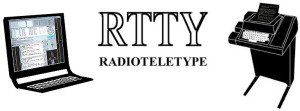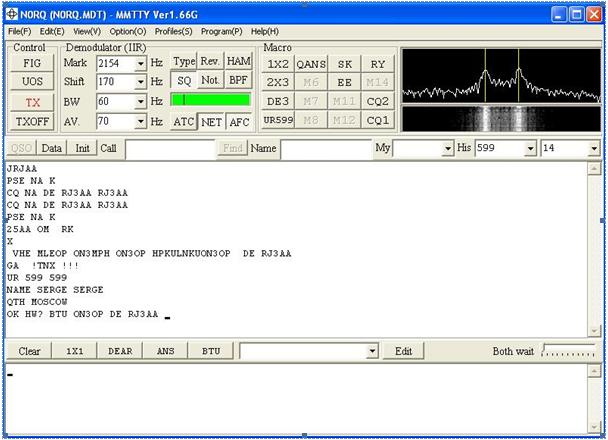Modes. Last month, we took a look at the most popular new digital mode, PSK31. So this month, I thought it worthwhile to look at the old digital mode, RTTY (pronounced “ritty”), which is short for “radio teletype”. It does not have error correction or a backspace, or even lower-case characters, all of which PSK31 enjoys. Some have suggested that RTTY will die because of advancements like PSK31 and other digital modes, but although that may be the case some day, RTTY is very much alive and well, and will be for the foreseeable future. Hams, if nothing else, hang on to their history quite well.
I’m not going to focus on the theory of it or even the history of it (it’s been around since 1953), but will instead discuss the practical implementation in your shack. Theory and history can be found at some of the links I’ve listed at the end of the article.
You’ll need an HF rig with SSB or RTTY capability,  a computer with RTTY software, and a sound card interface or TNC device. The interface is what sits between the rig and the computer. Note that different interfaces will do RTTY differently. There are two ways to transmit and receive RTTY: 1) AFSK, or audio frequency shift keying, is done in LSB mode, and 2) FSK, or frequency shift keying, is done in RTTY mode. Either works fine. What are they?
a computer with RTTY software, and a sound card interface or TNC device. The interface is what sits between the rig and the computer. Note that different interfaces will do RTTY differently. There are two ways to transmit and receive RTTY: 1) AFSK, or audio frequency shift keying, is done in LSB mode, and 2) FSK, or frequency shift keying, is done in RTTY mode. Either works fine. What are they?
If your rig doesn’t have a RTTY mode, or in the interface doesn’t support FSK RTTY, then you’ll need to do AFSK RTTY. The main disadvantage is that you won’t be able to take advantage of nice RTTY filtering (on receive) that some radios have. For AFSK, you’ll generally use LSB on all HF bands, but that really depends on your software. If you get the LSB/USB selection mixed up, you’ll be “reversed” and uncopyable. With AFSK, your RTTY signal will go out like voice audio, except that it will be RTTY tones.
If both the rig and the interface have FSK capability, this is usually the better way to go. You’ll need to set it up for FSK keying (different manufacturers do it differently), and there can be quite a few different cables to plug in – at least it is that way with my Icom and RigBlaster Pro. It is more complicated to set up than PSK31. But once set up, you’ll be in business. The best advice is to read and follow the instructions in the manuals of the radio and the interface. (Really – this is one instance where you actually should read the manual first!)
You’ll also need RTTY software, and you’ll be glad to know that it is free and there are several options, though the most popular one is called MMTTY. There are others you can try as well.
Here are a few things to remember when operating RTTY:
- It is not usually a low-power mode like PSK31. Most guys run a full 100w, if not more.
- Make sure you can decode a good RTTY signal before you start to transmit.
- Look for signals where RTTY is used – see the frequency list below.
Here is a screen shot of MMTTY.  In the upper-right corner is the signal received (both spectral and waterfall). You’ll see two peaks, which are the “mark” and the “space”. The two thin vertical yellow lines are there to help you tune in the signal – the mark and the space should line up with those lines.
In the upper-right corner is the signal received (both spectral and waterfall). You’ll see two peaks, which are the “mark” and the “space”. The two thin vertical yellow lines are there to help you tune in the signal – the mark and the space should line up with those lines.
There are lots of buttons to play with, including macros which are often used as shortcuts to typing common stuff over and over again. The green bar is the strength of the signal received.
The big window with text in it is the received text window. In this case, it shows RJ3AA calling CQ NA (North America), with ON3OP answering him (maybe he missed the “NA” part), and the Russian graciously answering him. At my station, the RJ3 was very strong and the ON3 was quite weak (on 20m).
The smaller white box at the bottom is the typing area for what is going to be transmitted. Yes, you can type in advance while receiving, so that when the other guy is done, you’ve done some of the typing ahead. The TX and TXOFF buttons flip between XMIT and RCV.
There are lots of options to set up in MMTTY, and it can be tricky. The best advice is to read the AA5AU link below for detailed instructions.
The common frequencies (in MHz) are shown below. Again, your rig must be in RTTY (FSK) or LSB (AFSK) mode!
- 160m – RTTY is rare, though if there, probably 1.800 to 1.820
- 80m – 3.580 to 3.600, sometimes 3.590 for DX
- 60m – (unknown, probably non-existent)
- 40m – 7.080 to 7.100, sometimes 7.040 for DX
- 30m – 10.130 to 10.136, but can vary
- 20m – 14.080 to 14.098
- 17m – 18.100 to 18.105, but can vary (try to stay away from 18.102 JT65 area)
- 15m – 21.080 to 21.100
- 12m – 24.920 to 24.925
- 10m – 28.080 to 28.100
- 6m – RTTY is rare, essentially non-existent
The “calling” frequency is generally the lowest freq in the range or just above it (i.e. 14.080); in other words, most RTTY activity is in the lower portion of the ranges given above. There is more RTTY activity on 20m than on any other band, so 14.080 to .085 is a good place to start.
NOTE: if you’re running AFSK (LSB), start 2.13 kHz below these listed frequencies, because the “dial” freq is off by that amount.
If you’re chasing a rare DX station, he may operate “split”, usually listening 1 to 5 kHz up. Just use your rig’s split freq (or VFO A/B) to transmit where he is listening. He’ll say what he is doing by transmitting something like “UP 2-4”.
One way to make a bunch of quickie contacts, after you’re set up and working, is to jump in the RTTY contests. Links for contest info are shown below.
This is way too short of an article to even come close to covering RTTY well, but it is easy to find tons of info. Just Google “RTTY”. A few good sources include:
- www.aa5au.com/rtty/ – great info, includes an excellent “getting started” section
- www.nonstopsystems.com/radio/frank_radio_rtty.htm – nice RTTY overview
- www.mcwa.org/AFSKvsFSK.pdf – discussion of AFSK vs. FSK
- www.ik3qar.it/rtty/3/ – a few short comments about AFSK vs. FSK
- en.wikipedia.org/wiki/Frequency-shift_keying – even more FSK vs. AFSK
- en.wikipedia.org/wiki/RTTY – more than you ever wanted to know
- www.rtty.com – lots of history, old equipment, etc
- www.n2ty.org/seasons/tara_seasons.html – RTTY and PSK contests
- www.rttycontesting.com – rather self-explanatory
- hamsoft.ca/pages/mmtty.php – where to download MMTTY
RYRYRYRYRY… Dave NØRQ
